An Ensemble Deep Neural Network-Based Method for Person Identification Using Electrocardiogram Signals Acquired on Different Days
Abstract
1. Introduction
2. Methods
2.1. Time-Frequency Representation via Continuous Wavelet Transform
2.2. Convolutional Neural Network for Image Classification
2.3. Preprocessing Methods for ECG Signals
3. Proposed Ensemble Deep Neural Network for Individual Identification Using ECG Signals
3.1. First Component for Individual Identification Using ECG
3.2. Second Component for Individual Identification Using ECG
3.3. Ensemble Neural Network
3.4. Evaluation Methods
4. Experiments and Results
4.1. ECG Datasets for Individual Identification
4.2. Experiments and Results
5. Conclusions
Author Contributions
Funding
Institutional Review Board Statement
Informed Consent Statement
Data Availability Statement
Conflicts of Interest
References
- Gahi, Y.; Lamrani, M.; Zoglat, A.; Guennoun, M.; Kapralos, B.; El-Khatib, K. Biometric Identification System Based on Electrocardiogram Data. In Proceedings of the New Technologies, Mobility and Security, Tangier, Morocco, 5–7 November 2008; pp. 1–4. [Google Scholar]
- Boles, W.W. A Security System Based on Human Iris Identification Using Wavelet Transform. In Proceedings of the First In-ternational Conference on Conventional and Knowledge Based Intelligent Electronics Systems, Adelaide, Australia, 21–23 May 1997; pp. 533–541. [Google Scholar]
- Zhang, Y.; Juhola, M. On biometrics with eye movements. IEEE J. Biomed. Health Inform. 2017, 21, 1360–1366. [Google Scholar] [CrossRef]
- Wang, H.; Hu, J.; Deng, W. Compressing fisher vector for robust face recognition. IEEE Access 2017, 5, 23157–23165. [Google Scholar] [CrossRef]
- Jain, A.K.; Arora, S.S.; Cao, K.; Best-Rowden, L.; Bhatnagar, A. Fingerprint recognition of young children. IEEE Trans. Inf. Forensics Secur. 2017, 12, 1505–1514. [Google Scholar] [CrossRef]
- Mobarakeh, A.K.; Carrillo, J.A.C.; Aguilar, J.J.C. Robust face recognition based on a new supervised kernel subspace learning method. Symmetry 2019, 19, 1643. [Google Scholar] [CrossRef] [PubMed]
- Pokhriyal, N.; Tayal, K.; Nwogu, I.; Govindaraju, V. Cognitive-biometric recognition from language usage: A feasibility study. IEEE Trans. Inf. Forensics Secur. 2017, 12, 134–143. [Google Scholar] [CrossRef]
- Nguyen, B.P.; Tay, W.L.; Chui, C.K. Robust biometric recognition from palm depth images for gloved hands. IEEE Trans. Hum.-Mach. Syst. 2015, 45, 799–804. [Google Scholar] [CrossRef]
- Wang, T.-W.; Lin, S.-F. Negative impedance capacitive electrode for ecg sensing through fabric layer. IEEE Trans. Instrum. Meas. 2021, 70, 4002308. [Google Scholar] [CrossRef]
- Wang, X.; Liu, S.; Zhu, M.; He, Y.; Wei, Z.; Wang, Y.; Xu, Y.; Pan, H.; Huang, W.; Chen, S.; et al. Flexible non-contact electrodes for wearable biosensors system on electrocardiogram monitoring in motion. Front. Neurosci. 2022, 16, 900146. [Google Scholar] [CrossRef]
- Patwary, A.B.; Chowdhury, M.T.I.; Mamun, N. Comparison among ECG filtering methods for non-linear noise. In Proceedings of the International Conference on Advancement in Electrical and Electronic Engineering, Gazipur, Bangladesh, 22–24 November 2018; p. 141. [Google Scholar]
- Lee, E.; Ho, A.; Wang, Y.-T.; Huang, C.-H.; Lee, C.-Y. Cross-Domain Adaptation for Biometric Identification Using Photoplethysmogram. In Proceedings of the IEEE International Conference on Acoustics, Speech and Signal Processing, Barcelona, Spain, 4–8 May 2020; pp. 1289–1293. [Google Scholar]
- Nazi, Z.A.; Biswas, A.; Rayhan, M.A.; Abir, T.A. Classification of ECG signals by dot residual LSTM network with data aug-mentation for anomaly detection. In Proceedings of the International Conference on Computer and Information Technology, Dhaka, Bangladesh, 18–20 December 2019; pp. 1–5. [Google Scholar]
- Chang, C.-H.; Wang, T.-M.; Hsu, H.L. Denoising of mixed noises in ecg with separate noise estimators based on discrete wavelet transform. In Proceedings of the IEEE International Conference on Advanced Materials for Science and Engineering, Tainan, Taiwan, 12–13 November 2016; pp. 562–564. [Google Scholar]
- Satija, U.; Ramkumar, B.; Manikandan, M.S. Automated ECG noise detection and classification system for unsupervised healthcare monitoring. IEEE J. Biomed. Health Inform. 2018, 22, 722–732. [Google Scholar] [CrossRef]
- Xu, X.; Cai, Q.; Wang, H.; Suo, Y.; Zhao, Y.; Tianwei, W.; Wang, G.; Lian, Y. A 12-Lead ECG Delineation Algorithm Based on a Quantized CNN-BiLSTM Auto-Encoder with 1–12 mapping. In Proceedings of the International Conference on Artificial In-telligence Circuits and Systems, Hangzhou, China, 11–13 June 2023; pp. 1–5. [Google Scholar]
- Yang, H.; Liu, J.; Zhang, L.; Li, Y.; Zhang, H. ProEGAN-MS: A progressive growing generative adversarial networks for elec-trocardiogram generation. IEEE Access 2021, 9, 52089–52100. [Google Scholar] [CrossRef]
- Anwar, T.; Zakir, S. Effect of image augmentation on ECG image classification using deep learning. In Proceedings of the International Conference on Aritificial Intelligence, Islamabad, Pakstan, 5–7 April 2021; pp. 182–186. [Google Scholar]
- Choi, S.; Seo, H.-C.; Cho, M.S.; Joo, S.; Nam, G.-B. Performace improvement of deep learning based multi-class ECG classifi-cation model using limited medical dataset. IEEE Access 2023, 11, 53185–53194. [Google Scholar]
- Cayce, G.I.; Depoian, A.C., II; Bailey, C.P.; Guturu, P. Improved neural network arrhythmia classification through integrated data augmentation. In Proceedings of the IEEE MetroCon, Hurst, TX, USA, 3 November 2022; pp. 1–3. [Google Scholar]
- Li, J.; Wang, G.; Chen, M.; Ding, Z.; Yang, H. Mixup asymmetric tri-training for heartbeat classification under domain shift. IEEE Signal Process. Lett. 2021, 28, 718–722. [Google Scholar] [CrossRef]
- Bazi, Y.; Alajlan, N.; AlHichri, H.; Malek, S. Domain adaptation methods for ECG classification. In Proceedings of the International Conference on Computer Medical Applications, Sousse, Tunisia, 22 April 2013; pp. 1–4. [Google Scholar]
- Rafi, T.H.; Ko, Y.W. Heartnet: Self multihead attention mechanism via convolutional network with adversarial data synthesis for ECG-based arrhythmia classification. IEEE Access 2022, 10, 100501–100512. [Google Scholar] [CrossRef]
- Alawad, M.; Wang, L. Learning domain shift in simulated and clinical data: Localizing the origin of ventiricular activation from 12-lead electrocardiograms. IEEE Trans. Med. Imaging 2019, 38, 1172–1184. [Google Scholar] [CrossRef] [PubMed]
- Yang, H.; Wei, Z. A novel approach for heart ventricular and atrial abnormalities detection bia an ensemble classification algorithm based on ecg morphological features. IEEE Access 2021, 9, 54757–54774. [Google Scholar] [CrossRef]
- Essa, E.; Xie, X. An ensemble of deep learning-based multi-model for ecg heartbeats arrhythmia classification. IEEE Access 2021, 9, 103452–103464. [Google Scholar] [CrossRef]
- Gupta, K.; Bajaj, V.; Ansari, I.A. Atrial fibrillation detection using electrocardiogram signal input to lmd and ensemble classifier. IEEE Sens. Lett. 2023, 7, 7002904. [Google Scholar] [CrossRef]
- Chen, J.; Li, H.; Zhang, L.-B.; Teng, Y.; Fortino, G. Emcnet: Ensemble multiscale convolutional neural network for single-lead ecg classification in wearable devices. IEEE Sens. J. 2024, 24, 8754–8762. [Google Scholar] [CrossRef]
- Liu, Y.; Fang, B.; Chen, Y.; Lv, Z. Ensemble learning-based atrial fibrillation detection from single lead ecg wave for wireless body sensor network. IEEE Trans. Netw. Sci. Eng. 2023, 10, 2627–2636. [Google Scholar] [CrossRef]
- Kim, M.-G.; Choi, C.; Pan, S.B. Ensemble networks for user recognition in various situations based on electrocardiogram. IEEE Access 2019, 8, 36527–36535. [Google Scholar] [CrossRef]
- Sun, Z.; Wang, C.; Zhao, Y.; Yan, C. Multi-label ecg signal classification based on ensemble classifier. IEEE Access 2020, 8, 117986–117996. [Google Scholar] [CrossRef]
- Prabhakararao, E.; Dandapat, S. Multi-scale convolutional neural network ensemble for multi-class arrhythmia classification. IEEE J. Biomed. Health Inform. 2022, 26, 3802–3812. [Google Scholar] [CrossRef] [PubMed]
- Gwak, J.; Hirao, A.; Shino, M. An investigation of early detection of driver drowsiness using ensemble mathine learning based on hybrid sensing. Appl. Sci. 2020, 10, 2890. [Google Scholar] [CrossRef]
- Lee, J.-A.; Kwak, K.-C. Personal identification using an ensemble approach of 1d-lstm and 2d-cnn with electrocardiogram signals. Appl. Sci. 2022, 12, 2692. [Google Scholar] [CrossRef]
- Lilly, J.M.; Olhede, S.C. On the analytic wavelet transform. IEEE Trans. Inf. Theory 2010, 56, 4135–4156. [Google Scholar] [CrossRef]
- Lilly, J.M.; Olhede, S.C. Generalized Morse wavelets as a superfamily of analytic wavelets. IEEE Trans. Signal Process. 2012, 60, 6036–6041. [Google Scholar] [CrossRef]
- Olhede, S.C.; Walden, A.T. Generalized morse wavelets. IEEE Trans. Signal Process. 2002, 50, 2661–2670. [Google Scholar] [CrossRef]
- Lilly, J.M.; Olhede, S.C. Higher-order properties of analytic wavelets. IEEE Trans. Signal Process. 2009, 57, 146–160. [Google Scholar] [CrossRef]
- Szegedy, C.; Liu, W.; Jia, Y.; Sermanet, P.; Reed, S.; Anguelov, D.; Erhan, D.; Vanhoucke, V.; Rabinovich, A. Going deeper with convolutions. In Proceedings of the IEEE Conference on Computer Vision and Pattern Recognition, Boston, MA, USA, 7–12 June 2015; pp. 1–9. [Google Scholar]
- Simonyan, K.; Zisserman, A. Very deep convolutional neural networks for large-scale image recognition. In Proceedings of the International Conference on Learning Representations, San Diego, CA, USA, 7–9 May 2015; pp. 1–14. [Google Scholar]
- He, K.; Zhang, X.; Ren, S.; Sun, J. Deep residual learning for image recognition. In Proceedings of the IEEE Conference on Computer Vision and Pattern Recognition, Las Vegas, NV, USA, 27–30 June 2016; pp. 770–778. [Google Scholar]
- Szegedy, C.; Loffe, S.; Vanhoucke, V.; Alemi, A.A. Inception-v4, inception-resnet and the impact of residual connections on learning. In Proceedings of the AAAI Conference on Artificial Intelligence, San Francisco, CA, USA, 4–9 February 2017; pp. 4278–4284. [Google Scholar]
- Zoph, B.; Vasudevan, V.; Shlens, J.; Le, Q.V. Learning transferable architectures for scalable image recognition. In Proceedings of the IEEE/CVF Conference on Computer Vision and Pattern Recognition, Lake City, UT, USA, 18–23 June 2018; pp. 8697–8710. [Google Scholar]
- Pan, J.; Tompkins, W.J. A real-time qrs detection algorithm. IEEE Trans. Biomed. Eng. 1985, BME-32, 230–236. [Google Scholar] [CrossRef]
- Schafer, R.W. What is a savitzky-golay filter? [lecture notes]. IEEE Signal Process. Mag. 2011, 28, 111–117. [Google Scholar] [CrossRef]
- Rahman, M.A.; Milu, M.M.H.; Anjum, A.; Khanam, F.; Ahmad, M. Baseline wandering removal from ecg signal by wandering path finding algorithm. In Proceedings of the 3rd International Conference on Electrical Information and Communication Technology, Khulna, Bangladesh, 7–9 December 2017; pp. 1–5. [Google Scholar]
- Choi, H.S.; Lee, B.H.; Yoon, S.R. Biometric authentication using noisy electrocardiograms acquired by mobile sensors. IEEE Access 2016, 4, 1266–1273. [Google Scholar] [CrossRef]
- Goldberger, A.L.; Amaral, L.N.; Glass, L.; Hausdorff, J.M.; Ivanov, P.C.; Mark, R.G.; Mietus, J.E.; Moody, G.B.; Peng, C.K.; Stanley, H.E. PhysioBank, PhysioToolkit, and PhysioNet: Components of a new research resource for complex physiologic signals. Circulation 2000, 101, e215–e220. [Google Scholar] [CrossRef]
- Wubbeler, G.; Stavridis, M.; Kreiseler, D.; Bousseljot, R.D.; Elster, C. Verification of humans using the electrocardiogram. Pattern Recognit. Lett. 2007, 28, 1172–1175. [Google Scholar] [CrossRef]
- Hamza, S.; Ayed, Y.B. An integration of features for person identification based on the pqrst fragments of ecg signals. Signal Image Video Process. 2022, 16, 2037–2043. [Google Scholar] [CrossRef]
- Lee, J.-N.; Byeon, Y.-H.; Pan, S.-B.; Kwak, K.-C. An eigenecg network approach based on pcanet for personal identification from ecg signal. Sensors 2018, 18, 4024. [Google Scholar] [CrossRef] [PubMed]
- Github-Senume. Available online: https://github.com/Senume/Person-identification-using-ECG (accessed on 10 July 2024).
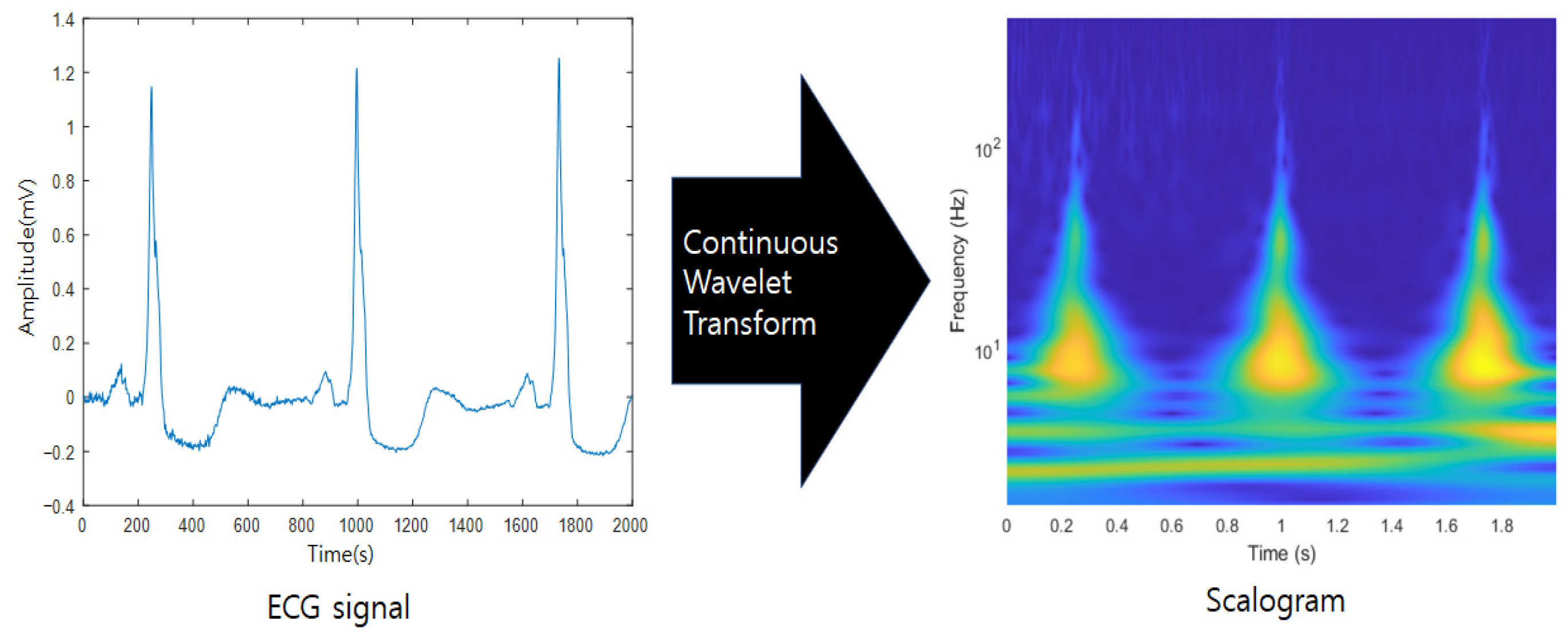



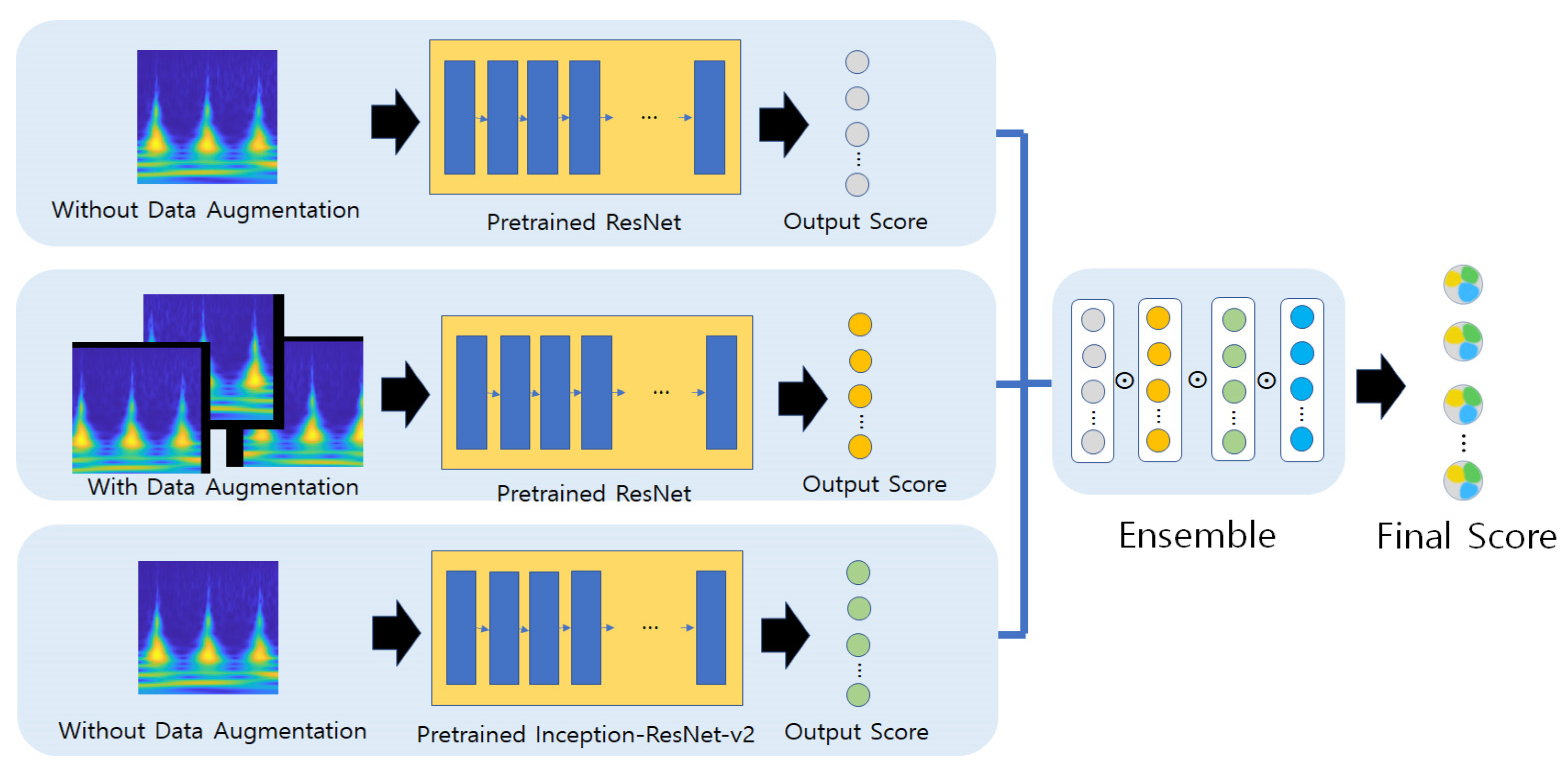

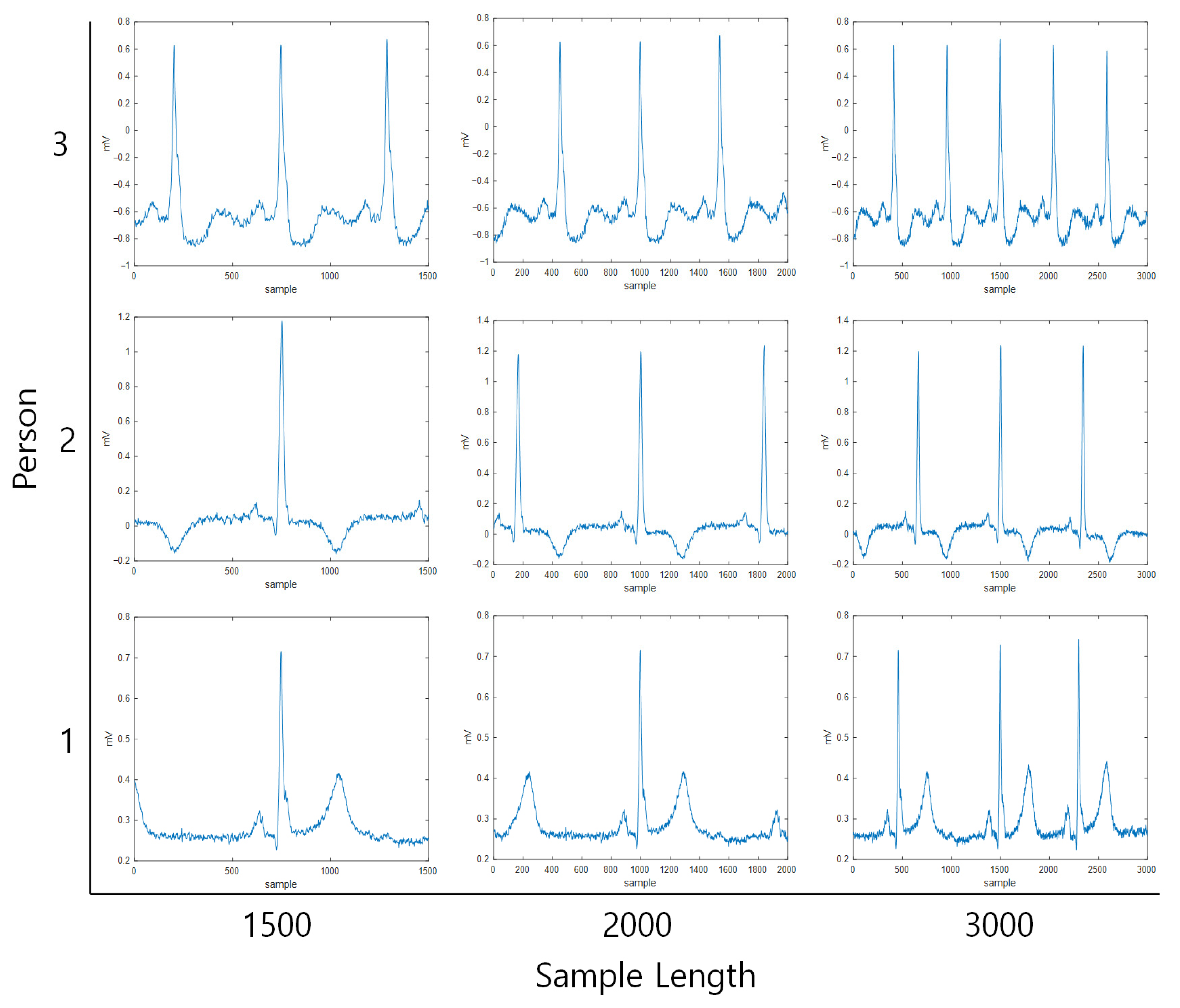
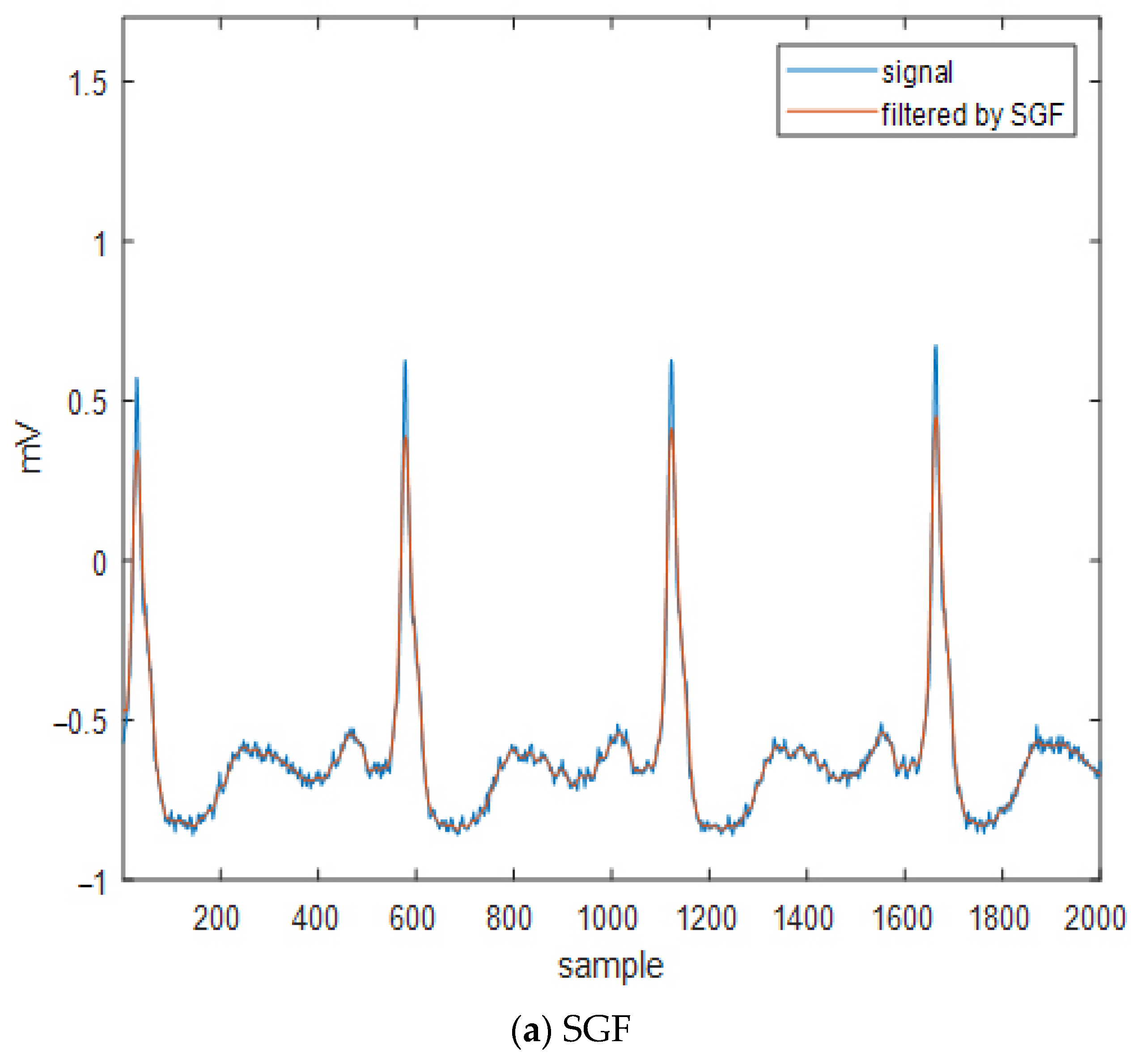
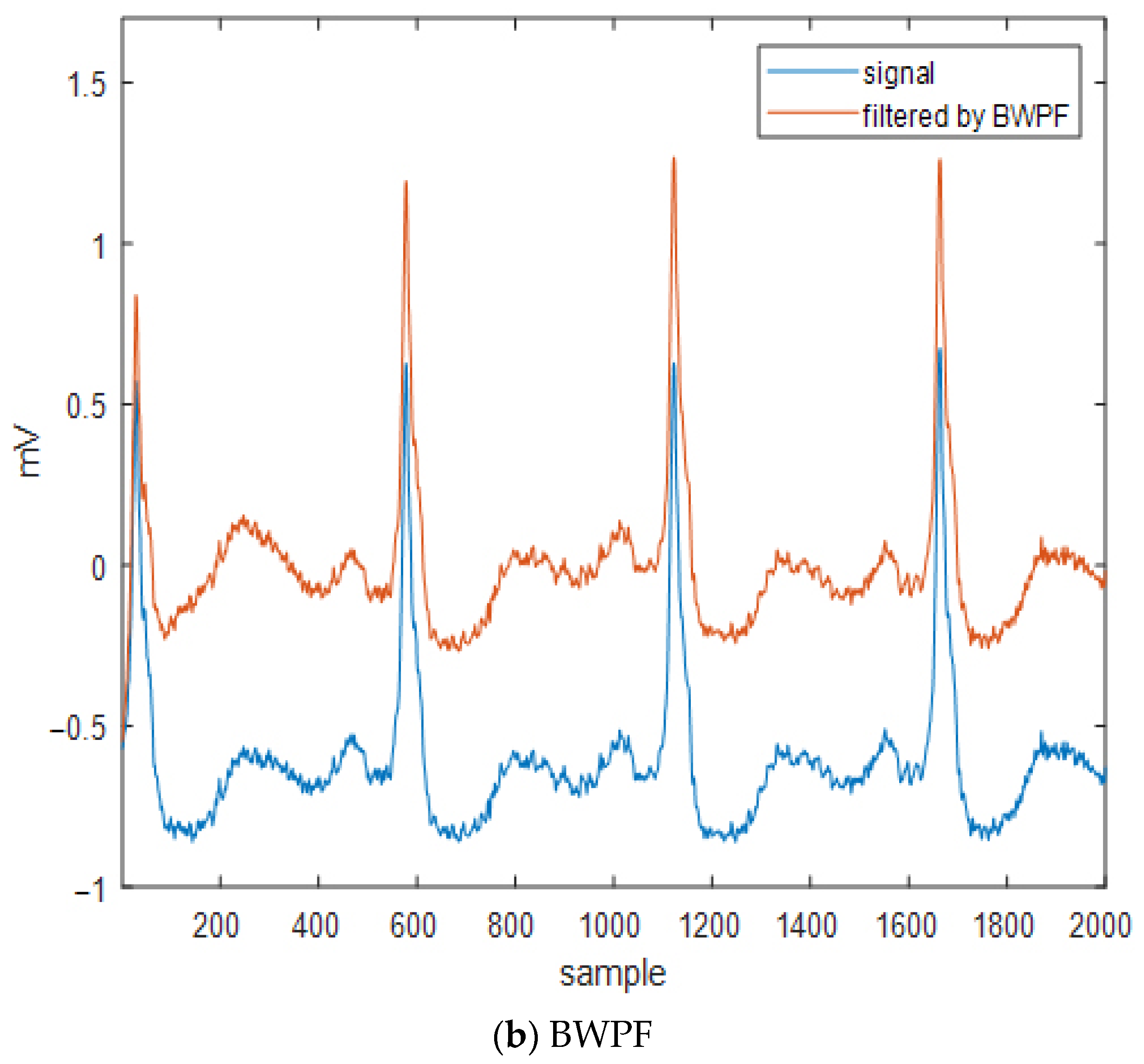
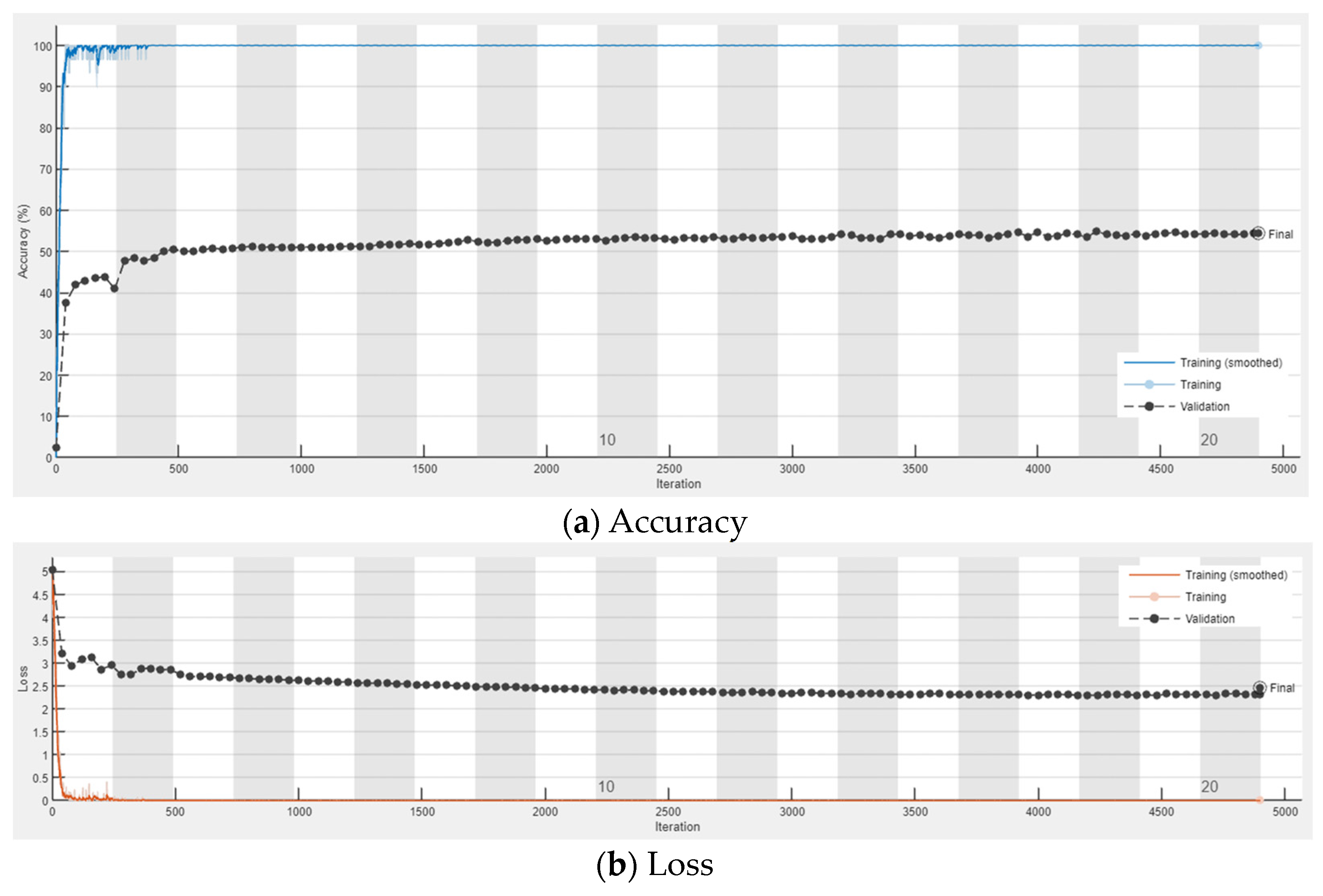


| Sample Length | Filtering | Accuracy (%) | Precision (%) | Recall (%) | F1-Score (%) | FRR (%) | FAR (%) |
|---|---|---|---|---|---|---|---|
| 1500 | - | 98.58 | 98.87 | 98.58 | 98.53 | 0.01 | 1.42 |
| 2000 | - | 99.48 | 99.52 | 99.48 | 99.48 | 0.00 | 0.52 |
| 3000 | SGF, BWPF | 98.94 | 99.13 | 98.94 | 98.88 | 0.01 | 1.06 |
| Sample Length | ECG Channel | Accuracy (%) | Precision (%) | Recall (%) | F1-Score (%) | FRR (%) | FAR (%) |
|---|---|---|---|---|---|---|---|
| 800 | 1 | 49.27 | 54.19 | 49.27 | 53.14 | 0.95 | 50.73 |
| 800 | 2 | 47.27 | 50.97 | 47.27 | 51.77 | 1.04 | 52.73 |
| 800 | 3 | 42.25 | 45.03 | 42.25 | 51.37 | 1.26 | 57.75 |
| Signal Segment Size | Signal Hop Size | Accuracy (%) |
|---|---|---|
| 800 | 10 | 22.80 |
| 800 | 50 | 20.74 |
| Sample Length | Accuracy (%) | Precision (%) | Recall (%) | F1-Score (%) | FRR (%) | FAR (%) |
|---|---|---|---|---|---|---|
| 1500 | 49.94 | 52.99 | 49.94 | 55.52 | 0.94 | 50.06 |
| 2000 | 55.08 | 54.23 | 55.08 | 59.13 | 0.77 | 44.92 |
| 3000 | 48.95 | 50.07 | 48.95 | 51.65 | 0.97 | 51.05 |
| Sample Length | Filtering | Accuracy (%) | Precision (%) | Recall (%) | F1-Score (%) | FRR (%) | FAR (%) |
|---|---|---|---|---|---|---|---|
| 2000 | SGF, BWPF | 13.71 | 41.18 | 13.71 | 18.09 | 4.01 | 86.29 |
| 2000 | SGF | 16.48 | 50.81 | 16.48 | 21.70 | 2.26 | 83.52 |
| 2000 | BWPF | 55.65 | 56.41 | 55.65 | 58.30 | 0.75 | 44.35 |
| 3000 | SGF, BWPF | 13.05 | 45.41 | 13.05 | 16.27 | 3.84 | 86.95 |
| Sample Length | Filtering | Accuracy (%) | Precision (%) | Recall (%) | F1-Score (%) | FRR (%) | FAR (%) |
|---|---|---|---|---|---|---|---|
| 1500 | BWPF | 45.59 | 52.76 | 45.59 | 50.32 | 1.11 | 54.41 |
| 2000 | BWPF | 55.65 | 56.41 | 55.65 | 58.30 | 0.75 | 44.35 |
| 3000 | BWPF | 54.95 | 55.19 | 54.95 | 58.43 | 0.77 | 45.05 |
| Sample Length | ECG Channel | Accuracy (%) | Precision (%) | Recall (%) | F1-Score (%) | FRR (%) | FAR (%) |
|---|---|---|---|---|---|---|---|
| 2000 | 1 + 2 | 46.95 | 49.13 | 46.95 | 52.07 | 1.05 | 53.05 |
| 2000 | 1 + 2 + 3 | 48.16 | 53.35 | 48.16 | 53.81 | 1.00 | 51.84 |
| Sample Length | Method | Accuracy (%) | Precision (%) | Recall (%) | F1-Score (%) | FRR (%) | FAR (%) |
|---|---|---|---|---|---|---|---|
| 2000 | ResNet-101 | 55.08 | 54.23 | 55.08 | 59.13 | 0.77 | 44.92 |
| 2000 | ResNet-101(aug) | 56.22 | 56.35 | 56.22 | 59.50 | 0.73 | 43.78 |
| 2000 | Inception-ResNet-v2 | 54.67 | 56.55 | 54.67 | 57.15 | 0.78 | 45.33 |
| Sample Length | Mothod | Accuracy (%) | Precision (%) | Recall (%) | F1-Score (%) | FRR (%) | FAR (%) |
|---|---|---|---|---|---|---|---|
| 2000 | EDNet-P | 58.79 | 58.71 | 58.79 | 61.26 | 0.66 | 41.21 |
| 2000 | EDNet-M | 59.11 | 60.05 | 59.11 | 60.73 | 0.65 | 40.89 |
| Combination of Models | Fusion Method | Accuracy (%) |
|---|---|---|
| ResNet, ResNet(aug) | Multiplication | 57.68 |
| ResNet, ResNet(aug) | Additon | 58.25 |
| ResNet(aug), Inception-ResNet-v2 | Multiplication | 56.32 |
| ResNet(aug), Inception-ResNet-v2 | Addition | 55.94 |
| ResNet, Inception-ResNet-v2 | Multiplication | 58.38 |
| ResNet, Inception-ResNet-v2 | Addition | 57.52 |
| Sample Length | Method | Noise Reduction | Accuracy (%) |
|---|---|---|---|
| 2000 | CZE-Linear-SVM [50] | - | 17.75 |
| 2000 | CZE-Polynomial-SVM [50] | - | 12.73 |
| 2000 | CZE-Rbf-SVM [50] | - | 15.71 |
| T-to-T wave | CZE-Linear-SVM [50] | - | 14.37 |
| T-to-T wave | CZE-Polynomial-SVM [50] | - | 12.16 |
| T-to-T wave | CZE-Linear-SVM [50] | - | 13.19 |
| 2000 | CZE-Linear-SVM [50] | Band Pass Filter | 0.98 |
| 2000 | CZE-Polynomial-SVM [50] | Band Pass Filter | 0.98 |
| 2000 | CZE-Rbf-SVM [50] | Band Pass Filter | 1.30 |
| 2000 | EECGNet-1 [51] | - | 55.40 |
| 2000 | EECGNet-2 [51] | - | 45.68 |
| 2000 | EECGNet-3 [51] | - | 39.37 |
| Stage | Patch-Size | Filter Number | Hist Block Size | Block Overlap Rate | Accuracy |
|---|---|---|---|---|---|
| 1 | 3 | 6 | 3, 3 | 0.5 | 49.17 |
| 2 | 3, 3 | 3, 3 | 3, 3 | 0.5 | 47.94 |
| 2 | 3, 3 | 6, 6 | 3, 3 | 0.5 | 54.44 |
| 2 | 3, 3 | 3, 3 | 7, 7 | 0.5 | 48.44 |
| 3 | 3, 3, 3 | 4, 4, 4 | 3, 3 | 0.5 | 55.37 |
| 3 | 7, 7, 7 | 6, 6, 6 | 7, 7 | 0.3 | 47.33 |
| 3 | 7, 7, 7 | 6, 6, 6 | 7, 7 | 0.5 | 47.59 |
Disclaimer/Publisher’s Note: The statements, opinions and data contained in all publications are solely those of the individual author(s) and contributor(s) and not of MDPI and/or the editor(s). MDPI and/or the editor(s) disclaim responsibility for any injury to people or property resulting from any ideas, methods, instructions or products referred to in the content. |
© 2024 by the authors. Licensee MDPI, Basel, Switzerland. This article is an open access article distributed under the terms and conditions of the Creative Commons Attribution (CC BY) license (https://creativecommons.org/licenses/by/4.0/).
Share and Cite
Byeon, Y.-H.; Kwak, K.-C. An Ensemble Deep Neural Network-Based Method for Person Identification Using Electrocardiogram Signals Acquired on Different Days. Appl. Sci. 2024, 14, 7959. https://doi.org/10.3390/app14177959
Byeon Y-H, Kwak K-C. An Ensemble Deep Neural Network-Based Method for Person Identification Using Electrocardiogram Signals Acquired on Different Days. Applied Sciences. 2024; 14(17):7959. https://doi.org/10.3390/app14177959
Chicago/Turabian StyleByeon, Yeong-Hyeon, and Keun-Chang Kwak. 2024. "An Ensemble Deep Neural Network-Based Method for Person Identification Using Electrocardiogram Signals Acquired on Different Days" Applied Sciences 14, no. 17: 7959. https://doi.org/10.3390/app14177959
APA StyleByeon, Y.-H., & Kwak, K.-C. (2024). An Ensemble Deep Neural Network-Based Method for Person Identification Using Electrocardiogram Signals Acquired on Different Days. Applied Sciences, 14(17), 7959. https://doi.org/10.3390/app14177959








